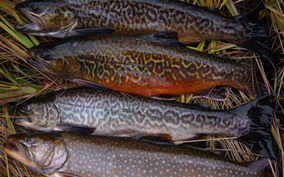
As a person who has been using ultralight spinning gear to fish for trout for more than twenty five years, I have learned that one of the best trout fishing techniques that there is is known as drift fishing. This unique fishing technique is simple in theory, a little more difficult in practice, and is easily the most effective trout fishing technique that I've ever been introduced to. In this article I will provide a little drift fishing 101 course, if you will, so that you can learn the basics of this extremely effective technique for trout fishing.
First of all, as you can probably imagine, "drift fishing" involves the act of allowing your bait or lure to drift with the current of the water that you are fishing. This obviously means that this particular technique is performed in the flowing water of a river or stream. I prefer to fish smaller rivers and streams, the kind that can be waded across in places, where riffles, runs, and pools are present. Many different species of freshwater fish are found in and are caught from this type of water such as; rainbow, brook, and brown trout, large and especially small mouth bass, as well as walleye and even whitefish.
Since you will more than likely be wading, the first key to drift fishing is where you position yourself in the river or stream that you are fishing. If possible you want to be just upstream of the part of the river that you want to fish and you want to cast directly across to current, to slightly upstream of where you are standing. As soon as your offering hits the water, the bail of your reel is closed, raise your rod tip a bit, and allow your bait for lure to begin to drift with the current until your bait is directly below you in the current.
In almost all drift fishing circumstances (especially when you are using live bait), you want your offering to bounce or "roll" along the bottom as it drifts. This means that split shot sinkers or tape lead needs to be added to your line before you cast, the amount of which will vary depending on current flow, water depth, wind conditions, etc. As you practice and become adept at drift fishing, it will almost definitely become one of the most effective trout fishing techniques that you have in your repertoire.
The biggest key to drift fishing, especially for the beginner is patience. Patience is the biggest key because the technique can be frustrating at times due to "getting snagged". As you gain experience this won't happen quite so often, but in the beginning getting the proper amount of weight for the "perfect drift" can be a challenge. Never forget what the man who taught me the technique for than a quarter of a century used to tell me, "If your not getting snagged, you're not fishing in the right place." Not to worry though, with practice the "getting snagged" thing becomes much less frequent. Not only that, but once you see how effective a trout fishing technique drift fishing is, you probably won't care much anyway.
Trevor Kugler is Co-founder of JRWfishing and has more than 25 years of fishing experience. He currently raises his eight year old daughter in the heart of trout fishing country... Montana. Check out our blog which is focused completely on trout fishing tips & tricks to help you be more successful on the water.
Article Source: http://EzineArticles.com/?expert=Trevor_Kugler
http://EzineArticles.com/?Trout-Fishing-Techniques---Drift-Fishing-101&id=7684438

